The terms ‘slope’, ‘angle’, or ‘pitch’ are often used to describe how steep a roof is. In the roofing industry, the term ‘pitch’ is most commonly used.
A roof is said to be ‘lower-pitch’ if its slope is closer to horizontal. The flatter the roof, the lower the pitch, and the steeper the roof, the higher the pitch.
Here in Colorado, where snow and rainfall can be quite variable, it helps to have roofs with a higher pitch. Higher-pitched roofs do a better job at shedding snow and reducing the amount of time that moisture remains on exterior roof materials after a weather event like a snowstorm or heavy rainstorm.
Roof Pitch Nomenclature
Roof pitch is typically measured in a ratio of inches in rise over inches in run. A roof rises as it goes up, and a roof runs as it traverses the horizontal plane. Using this method of denoting roof pitch, a completely flat roof would have a pitch of 0/12. This would mean that the roof rises zero inches for every 12 inches of roof run.
A roof with a pitch of 4/12 would rise four inches for every 12 inches of run.
A roof with a pitch of 6/12 (or ½, simplified) would rise six inches for every 12 inches of run.
…and so on.
The steepest roofs are often found on churches and chalet-style mountain homes. These roof types can have pitches as high as 12/12 or even higher!
Arriving at an accurate pitch calculation for any given roof can be done fairly quickly with a little know-how and some basic measuring instruments. Once you know the pitch of your roof, you can work with your roofer to determine the best roofing material, roof maintenance plan, and more.
Two Methods of Determining Roof Pitch
Let’s explore two common methods of taking an accurate roof pitch measurement.
First is the Rafter Method. This method is easily done without having to set foot on the roof itself, as long as you can safely access the attic of your home.
To perform a Rafter Method roof pitch measurement, follow these steps:
- Find a rafter in the attic, along an overhang, or at the side of a roof gable. You’ll want to locate at least a 12-inch-long section of rafter for easiest measuring.
- Using a carpenter’s level, find the flattest area along the rafter and mark off a 12-inch section.
- Using a tape measure, find the distance between both ends of the 12-inch section you marked and the inside wall of your roof.
- Subtract the height of the lower measurement from the height of the higher measurement. This is your ‘rise’ in inches.
- Putting the rise over the number 12 gives you your roof pitch!

The second method for calculating roof pitch is the Rooftop Method. This method will require you to access the roof, so be sure to follow safety measures and work with a partner if your roof is higher than a few feet off the ground.
To perform a Rooftop Method roof pitch measurement, follow these steps:
- Safely locate an accessible roof edge along the rake board.
- Using your carpenter’s level, make a 12-inch measurement along the rake board, ensuring that the measured section is completely level (refer to the levelling bubble on the carpenter’s level for confirmation).
- Now, measure the vertical distance from the ends of both sides of your 12-inch measurement to the surface of your roof.
- As with the Rafter Method, subtract the height of the lower measurement from the height of the higher measurement. The lower measurement will be zero if you positioned your carpenter’s level flush against the roof edge before taking your measurements. The number you’re left with is the rise of your roof.
- Putting the rise above the number 12 gives you your roof pitch.
Remember that roof pitch, slope, and angle can vary depending on different features and sections of a roof. Very few roofs have only one surface, which may mean that taking multiple pitch measurements could be necessary to arrive at a complete picture of the roofs dimensions.
Gabled windows, eaves, valleys, and other inclusions can add complexity to roof measurements. For best results, we highly suggest contacting the professionals at A-to-Z Roofing & Exteriors to have an accurate roof pitch measurement performed.
The better you know your roof, the better informed you will be when the time comes to repair, replace, or upgrade it.
For all of your other roofing-related questions, reach out to us for fast, accurate answers!

